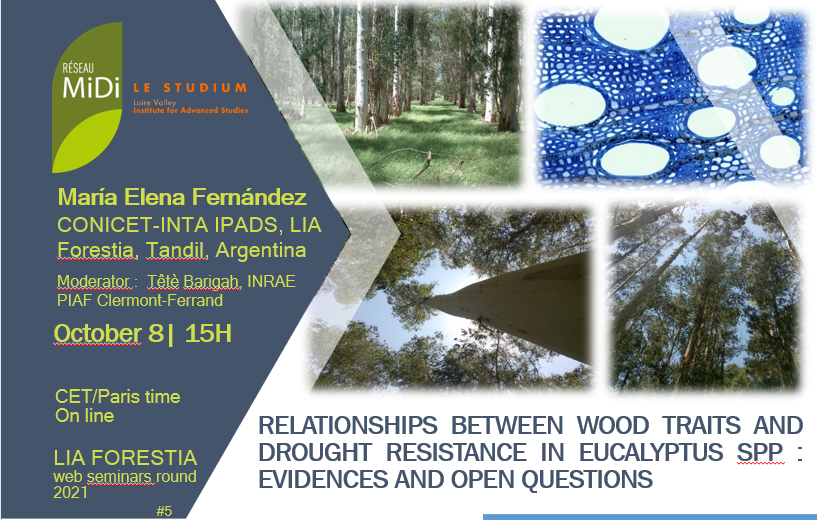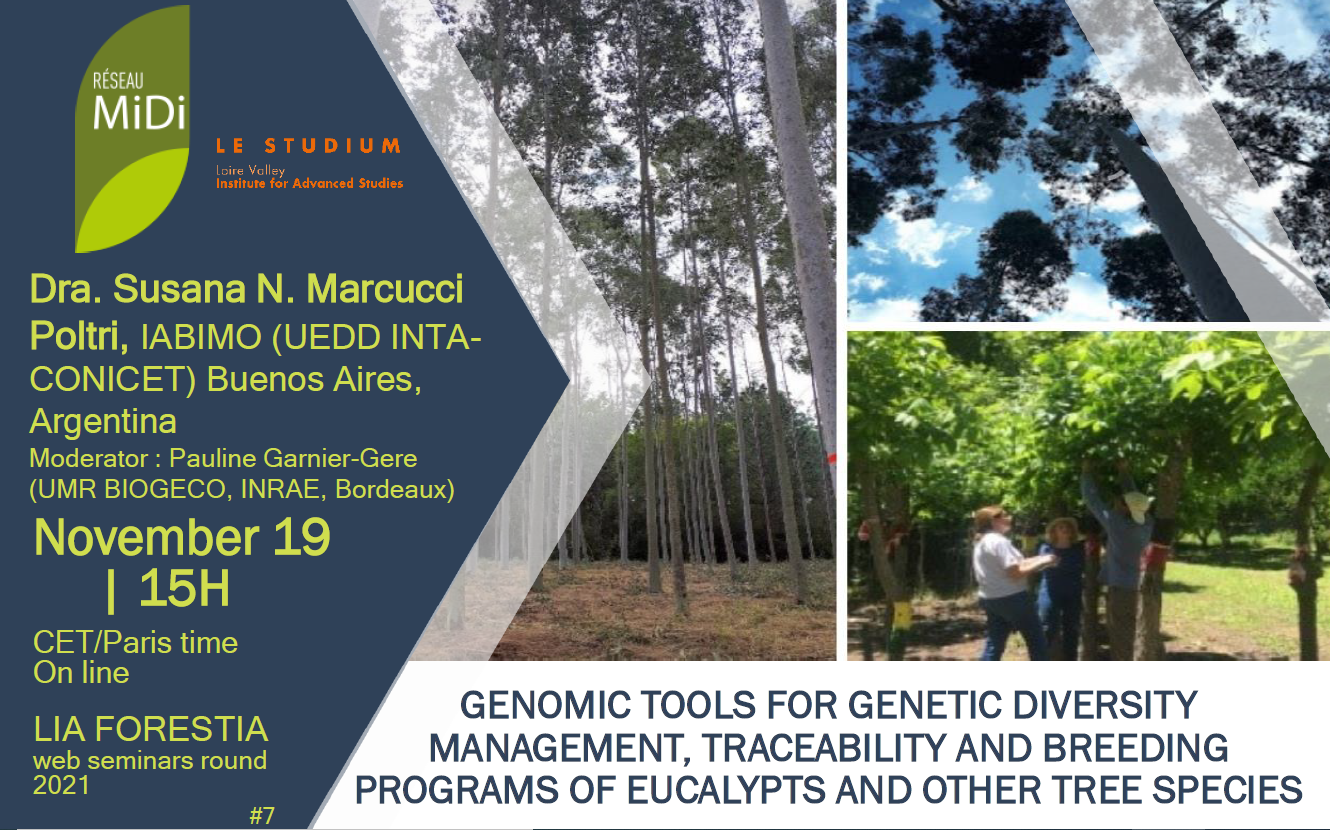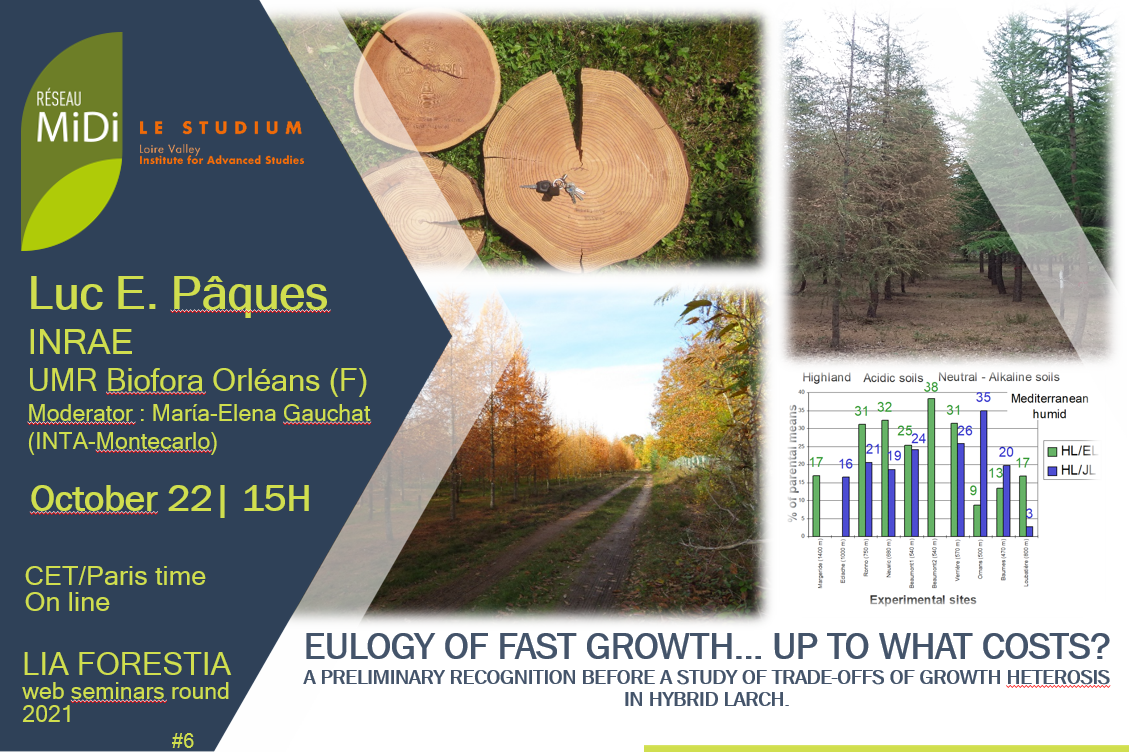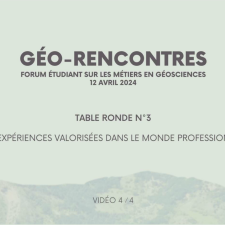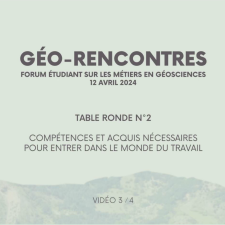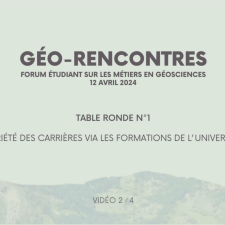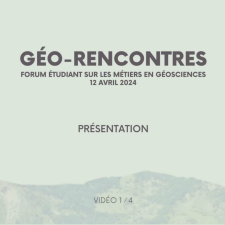Notice
#4 Ecophysiology of tree ring formation: concepts, methods and applications
- document 1 document 2 document 3
- niveau 1 niveau 2 niveau 3
Descriptif
Round of FORESTIA web seminars
SEMINAR # 4
Ecophysiology of tree ring formation: concepts, methods and applications
Cyrille Rathgeber (SYLVA INRAE Nancy)
August 27 at 15h (CET/Paris time)
The International Associated Laboratory FORESTIA starts in 2021 a new round of short seminars aimed at stimulating the scientific comunication among its members, as well as between them and other international laboratories. These seminars are a new opportunity for the FORESTIA scientists to present and discuss their objectives, research work and results on adaptation of forest ecosystems to global changes.
Seminar #4 by Cyrille Rathgeber (SILVA INRAE Nancy)
Abstract
Wood, the most abundant biological compound on earth, is of crucial importance to humanity and the biosphere. Although tree rings and the process of xylogenesis that creates them, have long been under the microscope of biologists, it is only recently that the invention of new techniques has made it possible to follow the intra-annual dynamics of xylem formation by the cambium, as well as the environmental conditions that influence it.
In most parts of the world, cambium activity follows a seasonal cycle. At the beginning of the growing season, when temperature rises, the cambium resumes its activity.
During the growing season, the new xylem cells produced by the cambium undergo profound transformations, passing through successive stages of differentiation, which will enable them to fulfil their future functions in trees. Finally, at the end of the growing season, when climatic conditions deteriorate, the activity of the cambium stops, followed rapidly by the cessation of all differentiation processes.
In this presentation, after reviewing the biological basis of wood formation and describing the methods to monitor it, we investigate and model the relationships between cambium phenology, tree-ring formation dynamics, tracheid differentiation kinetics and climatic factors. The results are used to describe the coordination between stem growth in size and biomass, as well as the relationships between the source (the canopy) and the main sink (the cambium) ofarbon in trees.
Finally, three promising avenues of research will be presented, exploring the relationships between: (1) intraannual dynamics of woody biomass production and gross primary productivity; (2) intra-annual dynamics of xylem water conduction and stem sap flow and stand evapotranspiration; and (3) kinetics of tracheid differentiation and the generation of isotopic signals in the tree-ring archive.
In the context of accelerating global change, it is crucial to study what governs tree-ring formation and wood production, in order to better assess how ongoing changes in environmental factors affect trees, biogeochemical cycles, human societies and, ultimately, the climate itself.
Moderator :Anne-Sophie Sergent (Moderator) - INTA Bariloche, Argentina
Dans la même collection
-
#5 Relationships between wood traits and drought resistance in Eucalyptus spp: evidences and open q…
Round of FORESTIA web seminars SEMINAR # 5 “Relationships between wood traits and drought resistance in Eucalyptus spp: evidences and open questions” Dr. María Elena
-
#7 Genomic tools for genetic diversity management, traceability and breeding programs of eucalypts …
Our group works on the development and application of different genomic tools to support INTA´s forest and fruit breeding programs distributed throughout Argentina.
-
#6 Eulogy of fast growth… up to what costs? A preliminary recognition before a study of trade-offs…
Round of FORESTIA web seminars SEMINAR # 6 “Eulogy of fast growth… up to what costs? A preliminary recognition before a study of trade-offs of growth heterosis in hybrid larch.” Luc E.
-
#3 The challenge of the integrating the adaptive and technological value of wood in a changing clim…
Round of FORESTIA web seminars SEMINAR # 3 The challenge of the integrating the adaptive and technological value of wood in a changing climate Guillermina Dalla-Salda (INTA Bariloche
-
#1 Deciphering tree response to a changing climate
Round of FORESTIA web seminars SEMINAR # 1 Deciphering tree response to a changing climate Where are we? where do we go? a case study: southern beeches of Patagonia María Verónica
Sur le même thème
-
Géo-Rencontres 2024 / Les expériences valorisées dans le monde professionnel
LilloEmmaAraujoJulieHuartFlorianDubreuRomainBuquetDamienChazalLauraBorieMarianeForum sur les métiers en géosciences organisé par les étudiants du CMI Ingénierie Géologique et Civile, Université de Bordeaux, 12 avril 2024
-
Géo-Rencontres 2024 / Compétences et acquis nécessaires pour entrer dans le monde du travail
BrinonJulietteAmoleFili-FenuaPretouFrédéricCampetHugoLiébauxAlbinDe AlemeidaMarie-LouPoirierAymericDufrenoyAudreyForum sur les métiers en géosciences organisé par les étudiants du CMI Ingénierie Géologique et Civile, Université de Bordeaux, 12 avril 2024
-
Géo-Rencontres 2024 / Variété des carrières via les formations de l'université
InguimbertDianeLacazeRomaneLemaitreLaurieChazalLauraMontjeanPascalPoudevigneJacquesPortefaixFrédéricForum sur les métiers en géosciences organisé par les étudiants du CMI Ingénierie Géologique et Civile, Université de Bordeaux, 12 avril 2024
-
Géo-Rencontres 2024 / Présentation
LatasteJean-FrançoisLavieThéoForum sur les métiers en géosciences organisé par les étudiants du CMI Ingénierie Géologique et Civile, Université de Bordeaux, 12 avril 2024
-
#6 Eulogy of fast growth… up to what costs? A preliminary recognition before a study of trade-offs…
Round of FORESTIA web seminars SEMINAR # 6 “Eulogy of fast growth… up to what costs? A preliminary recognition before a study of trade-offs of growth heterosis in hybrid larch.” Luc E.
-
#7 Genomic tools for genetic diversity management, traceability and breeding programs of eucalypts …
Our group works on the development and application of different genomic tools to support INTA´s forest and fruit breeding programs distributed throughout Argentina.
-
#5 Relationships between wood traits and drought resistance in Eucalyptus spp: evidences and open q…
Round of FORESTIA web seminars SEMINAR # 5 “Relationships between wood traits and drought resistance in Eucalyptus spp: evidences and open questions” Dr. María Elena
-
#3 The challenge of the integrating the adaptive and technological value of wood in a changing clim…
Round of FORESTIA web seminars SEMINAR # 3 The challenge of the integrating the adaptive and technological value of wood in a changing climate Guillermina Dalla-Salda (INTA Bariloche
-
S1- Horizon Europe: EU funded research and Community building in the area of climate and weather ex…
Horizon Europe: EU funded research and Community building in the area of climate and weather extreme events Philippe Quevauviller (Innovation and Industry for Security, DG HOME, European Commission,
-
S3- Wood, tree-ring and hydraulic studies of adaptation to drought in forest trees
Wood, tree-ring and hydraulic studies of adaptation to drought in forest trees Philippe Rozenberg (BIOFORA INRAE, Orléans)
-
S2-Dynamics of hydrometeorological extremes in Southern Germany and the Alps
Dynamics of hydrometeorological extremes in Southern Germany and the Alps Ralf Ludwig (Co-Chair, of the Collaborative programmes of ECRA on Hydological Cycle; LMU, Germany)
-
S1- Opening of the symposium : The state of global climate change
Opening of the symposium : The state of global climate change Hervé Le Treut (Dir. IPSL, Paris)


